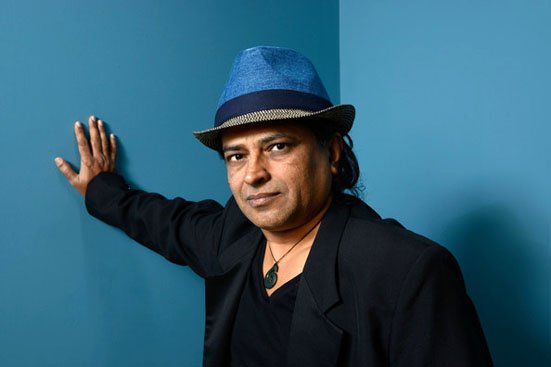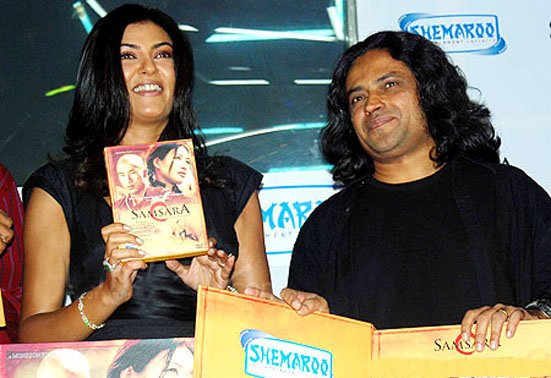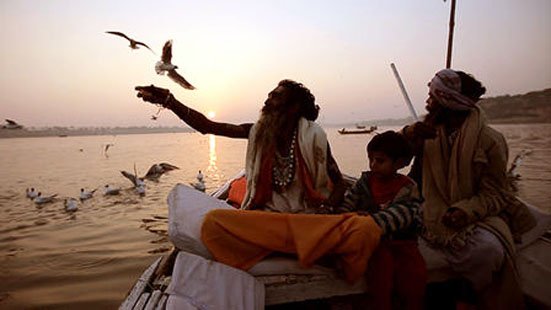
For all his accomplishments abroad, Pan Nalin can be seen as a hidden gem. His films get picked up for distribution with a snap by people from different countries. And his films are used in the most creative of ways. His Samsara was used as part of an 8-week curriculum at the University of Bangkok and a Canadian psychiatrist has been inspired to use his latest film Faith Connections to explain concepts of human faith and rationality.
So for a man who began with the cartoonist RK Laxman, he has certainly come a long way. So here Minority-Review’s Swati Sharan brings you glimpses from an interview with Pan Nalin at TIFF 2013.
Where in Gujarat are you from?
I am from Umbreli near Rajkot.
So tell me about how you’ve come from a town like Umbreli and blossomed to a point to come here to Toronto.
I come from an even smaller remote village called Adtala near Umbreli. My childhood was on the edge of Sasangir. I was born and brought up there. Later for educational purposes, we moved to Umbreli. And since I was a kid, I always wanted to make films. I had a good drawing teacher who had told me that I needed to learn English because I was studying only in Hindi and Gujarati. I also needed to get the hell out of this village. So to go to film school, one had to be a graduate and wait and apply. So I thought that means I’ll have to wait 14 years to make a movie. So I applied for fine arts. While doing painting and design, I became a self-taught filmmaker. I got a small video camera and started making movies. I used to do wedding videos to finance my education because I was from a very modest family. And ultimately, when you’re in India and you do cinema, you end up in Mumbai.
But the moment I came there, all my dreams were shattered because I had an image of cinema being great. I’d seen world cinema. I’d seen everything. But Mumbai was very much about dynasty, family, Bollywood stars at that time. Now things are changing. But at that time, it was so difficult to penetrate. And the only thing you could do was television and ad films or commercials. So I started doing that. And that’s how I wrote Wagle Ki Duniya. But that’s not what I wanted. I really wanted to make my movies that should be seen around the world. So the easiest thing for me was to branch out into documentaries. I worked with the BBC, Discovery and these documentaries were shown and became very popular. And then I started working on my first fiction film called Samsara, which sort of started my career here in Toronto. The World Premiere was here. It did extremely well critically and commercially. It became one of the top grossing Indian films in the world. Like there were films like Lagaan and Devdas and in the 3rd position was Samsara.
So since then I made another epic film called Valley of Flowers with Milind Soman and Naseerudin Shah. I also did another documentary on Ayurveda called The Art of Being. In short, I have quite a few projects. And now, Faith Connections is showing here at TIFF.

Sushmita Sen and Pan Nalin at the Samsara DVD launch
I notice you have a tendency to use spiritual themes. What has intrigued you towards this?
Spirituality was always there in the family. Most of the religions are getting a bad name. So the only thing one needs to hold on to is the spiritual aspect. And then Kumbh mela is one such event, which will now only come again in 2025. So as a filmmaker I was very curious, what happens there? What do the people do? Is it blind faith or the power of devotion?
It’s also the confluence of people who have renounced the world and those who live in it. It was like a river of people who otherwise don’t meet or mingle with one another on this scale. For me, spirituality need not be religious. You could be doing a job of NGOs saving forests or you could be helping refugees or Medecins Sans Frontiers helping people where they need medicine urgently. They all have a kind of spirituality of their own. They might not be practising any religion. I admire and respect that. That fascinates me as a storyteller. People do awaken to bigger truths and they realise they should be humble. And I find those stories of transformation to be uplifting.
With Faith Connections that there was not as much addressing of the concept of anubhooti or the divine experience. (He asks me to clarify about what I meant about anubhooti and I give him a rough breakdown about kundalini awakening and the thought-free state.)
Kumbh Mela is not the place for that. Kumbh is a very simple destination. It’s for the holy dip and satsang (collective gathering), as they call it. You get the blessings of the masters with like-minded people and you listen to spiritual tales and you go and take a holy dip. It’s not a place to get enlightened and reach on another plane or get into trance in meditation. When you come here, your karma will be good. Your sin might be wiped out. And your future might be better. You’ll not only be helping yourself but the whole family. So it’s not the place where people would want more than that. It is, after all, a Mela or fair. You do the holy thing and have spiritual fun. They sing bhajans, take a nice road walk along the Ganges, feed the birds, or help the poor people.

A still from Fraith Connections
Your points are fair but in your film, Hath Yogi Baba was the only one I found that came close to even describing some of those things relating to divine experience.
Yes. He’s someone who is genuinely enlightened. But he didn’t get that from the Kumbh Mela. He got that from being in the Himalayas for 12 years. So you had people like him. Then you had those two young sadhus who talk about Kishan. They are in the process. They are smoking, kidding around. They’re young. So it’s not easy for everyone to achieve what hath yogi baba has done. His body is elastic. His only strength is mind. He has a humility and compassion like you’ve never seen anywhere on earth. So to develop this faculty, it needs a big tapasya (penance).
And what’s really surprising is how someone like him will be heading for nirvana but because of this kid he’s looking after, he’s sacrificing 20 years of tapasya to return to the world, look after him.
We have a ritualistic facet of Hindu society and we have a spiritually elevated facet of society, which generally doesn’t go along with the former. What do you think of the divorce between the two?
I think sadly it is bound to happen because there are a lot of people who are very spiritual. They say that vahan nahin jaana hai, tamasha hai. There’s that view also. And then there are others who believe let others do what they may. Let them exploit but we’ve come with our own devotion. Food may be expensive or people may think the water is dirty. But we have come here with our faith. We’ll drink the water or take a dip in it. And that power is absolutely astonishing. In that course of time, there are 80 to 100 million people and why didn’t a hospital get filled with infection, viral diseases and diarrhea? And there are people dipping in the same water from which others are drinking. We can look into scientific reasons, which may suggest something along the lines of immunity. But for some it’s faith. But it’s an exceptional phenomenon. And even the non-believers could start to wonder.

So have you had a divine experience?
I have dealt with Hinduism of course. I did films with Buddhism. I even wrote a script on Islam called The Prophet and the Emperor. So for me, a spiritual experience could be as simple as a writer’s work becoming a form of meditation because of the experience of writing itself. I find that is more spiritually enlightening. When you start enjoying what you are doing. I don’t believe one needs to seclude oneself so that the divine intervention will come to you. So I think you have to live in the world. And like the Buddhist teaching says, it should be here and now.
I met someone who had a revelation while he was at the stock exchange. He said he took his Harley Davidson and just left. And then his bosses said, “We’ll fire you.” And he said, “It doesn’t matter. Fire me.” And then he just drove and spent some time with homeless people in the U.S. Then he went to the west coast and met a Shaman and spent time with him. So this was a 25-year-old man from a rich family. So maybe he didn’t know that one may call this ‘anubhooti’ but that’s what he had. So after spending this time after 1 and half year, he said “I was a transformed man. I didn’t go to any holy places. I just crossed the U.S.”
So one may say he was responding to the voice of the soul or atma ki avaaz. Do you ever feel this too?
I do feel sometimes while working, I am getting a revelation or divine callings doing my work. Like I got this even while I was working on Race, which is about Jesse Owen who was an African American athlete in 1936 Berlin Olympics. He won 4 gold medals and pissed off Hitler. Hitler was obsessed with the master race and Jesse Owens was obsessed with winning a race. I don’t like films that teach, preach or inform. I find that very boring. I’d like to entertain people and somewhere along the way inspire them.
Watch the trailer of Faith Connections here:
“Faith Connections” – a Pan Nalin film [ Trailer ] from rapsodieproduction on Vimeo.
Press Conferences and WINNERS LIST here
Read the 3rd Set of Film Reviews (including Qissa and Words & Pictures) from TIFF 2013 here



0
comments